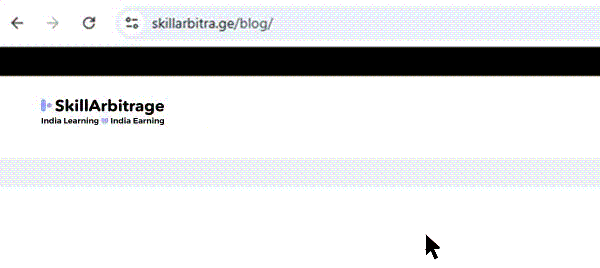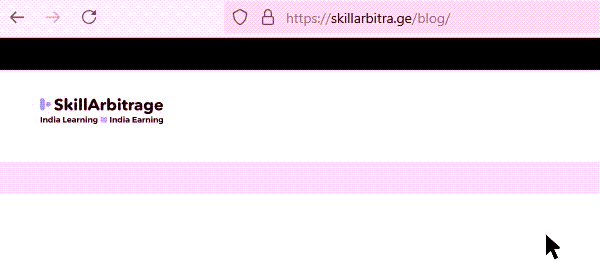
Q1. Can you explain to our listeners what digital banking, or e-banking, is and how it differs from traditional banking methods?
Digital Banking & E-banking are one & same. All transactions and documents maintained are in electronic form, nothing is stored physically as it is done in traditional banks . It is clear that banking has undergone many changes over time, but now we are at an important era, in which we must detect the opportunities that digital banking brings us, both for business and for consumers. In DB(Digital Banking) one can do transactions 24*7, sitting at any convenient location with speed and accuracy which is not possible in TB(traditional banking).
Q2. With your extensive experience in the banking industry, what do you see as the scope of digital banking in India? How has it evolved over the years?
India being one of the emerging nation, with a huge population and large market size, it could not remain back in not acknowledging the change in banking sector as bank is the life line of any economy. Hence India embraced and adapted changes in technology in banking. The visible change can be tracked back to nationalization of banks in 1969, where it was a paradigm shift from class to mass banking. Slowly banking picked up in 1990’s when India opened its economy under dynamic leadership of PM Mr. PV Narasimha Rao & the under visionary leadership of PM, Manmohan Singh who opened Indian banks to international arena inviting MN Banks to set up their branches in India. Many Foreign Banks opened their branches in India bringing capital, new technology and efficient management. Banking was opened to Private sector where banks like Kotak Mahendra, Indus Ind Bank, HDFC Bank, ICICI Bank, Axis Bank (erstwhile UTI Bank), Bank of Punjab etc were set up fostering competition and growth. In recent years we have witnessed massive growth of banks with new policy of Financial Inclusion wherein unbanked and underbanked areas are covered by banking facilities.
Q3. Digital banking has not gained universal acceptance among the general masses. In your opinion, what are the key challenges that need to be addressed to improve its adoption and accessibility?
People’s perception about online fraud and hacking has created suspicion in the minds of the general masses. It is true that gullible people are made the scape goat, more so the senior citizens and the illiterate. The hackers are one step ahead than bankers and they find ways and means of cheating and hacking the account. Banks are taking steps to curb this menace. Cyber laws have been made more stringent and encryption of transactions are made hacking proof. Banks should constantly upgrade their technology and should quickly investigate the case of frauds etc.
Q4. The Reserve Bank of India (RBI) has been cautious in granting licenses to operate digital banks. Could you shed some light on the reasons behind this approach?
RBI at present is not very sure of the performance of digital banks as it is in stage of transition and change. The systems and procedures of digital banking are yet to stabilize. RBI does not want to take any risk of default by the new digital banks, hence they are asked to under the guidance of banks whose systems and procedures have been established. Digital banks at present are mainly Fintech companies who they are bringing new customers under their fold. Established commercial banks earn some revenue out of their association with such Fintech companies.
Q5. In the realm of digital banking, what are the major tools and technologies used to enhance customer experience and operational efficiency?
New technologies like blockchain, artificial intelligence (AI), and the Internet of Things (IoT)will have the greatest impact on banking. Robots will soon replace human in banks. Wearables are the new fad with Gen X, it can be used for multiple purposes including banking.
Some of the new gen banks are:
- Chime: This US based bank provides fee-free financial services through its mobile app. It recently launched a new Visa credit card, designed to help customers build a credit history. And during the coronavirus pandemic, Chime built customer loyalty by rolling out $200 stimulus check advances to 100,000 customers.
- N26: This German-headquartered neo bank has no branch network, meaning it reaches consumers completely virtually. N26 products include a free checking account, personal loans, and a suite of PFM tools.
- Personal Capital: This US-headquartered direct-to-consumer (D2C) digital wealth manager offers savings and retirement planning services.
- Varo: In 2020, Varo became the first neo bank to receive FDIC approval and to receive a national bank charter. According to Insider Intelligence, Varo plans to use the approval to add credit products such as short-term loans, credit cards, and home financing.
- Cleo: You may recognize this service from Facebook Messenger. This AI-powered money management chatbot is now offered as an app that pulls in customers’ bank data to analyze spending in real time and generate personalized financial insights.
Q6. As an expert in bank management and financial restructuring, how do you see digital banking impacting the management and handling of stressed assets in the banking sector?
Technology if used efficiently and due diligence of loan accounts can bring about a large reduction of NPA which happens majorly due two psychological traits like intention and ability of the defaulter. Intention can change very fast and is unpredictable. There are no machine to gauze it further the intending defaulter have malafide intentions to defraud banks. He takes loan and runs away like Vijay Mallya or Neerav Modi who have ability to pay but will not pay the money. At times stressed assets are due to bankers who will stoop low to do anything. Our legal systems too are responsible for this state of affairs as courts take too much time to conclude a case. New tools like CRM can to an extent indicate whether loan should be given to a particular individual or not by analysing his traits and financial history.
Q7. You served as the CEO of Maiwand Bank in Kabul, Afghanistan. Could you share some insights into the unique challenges and opportunities of implementing digital banking in a country like Afghanistan?
The literacy rate in Afghanistan was very poor and more so with female population. Due to ethnic and religious reasons they are not encouraged to study. We had difficulty in extending banking services to this section of population. Further Afghanistan has vast hilly terrain and unhospitable climate where it is not possible to set up branches. In such areas branchless banking and ebanking was successful. We employed female staff to reach to this group. Since mobile penetration was as high as 70% hence a large section of the population was using mobile banking which was a big success there. Although there are many challenges but opportunities are immense to do business.
Q8. As the Managing Editor of the “IJRB” journal, which is focused on banking and finance, what trends have you observed in research related to digital banking and its implications?
I was faculty at Emirates Institute of Banking and Financial Studies (EIBFS), Dubai now known as EIF which is a premier banking training institute. The banking system is UAE is robust and there are many foreign and local banks having high level of competition and focus was on research and development of innovative banking. As Managing Editor I used to interact with CEO of the banks to promote more research and train the staff for quality banking. The articles in the magazine was mainly contributed by foreign nationals working in the bank but I used to encourage the locals to contribute small articles and share their interaction with the customers.
Q9. Having taught and trained bankers in various countries, what are the notable differences in the adoption and implementation of digital banking in India compared to other regions?
One of the major advantage in adoption of digital banking in India is that the staff can read and write English comfortably than the bank employees working in UAE. Indians are more tech savvy and can easily adopt the changes.
Q10. In your opinion, what would be the critical skills and knowledge that future banking professionals need to possess to thrive in the digital banking landscape?
The future staff should be tech savvy and multi- tasking. They should upgrade their skill frequently if they have to be relevant. They should learn and unlearn as well.
Q11. As an educator in the banking and finance field, how do you see the role of academic institutions in preparing students for the evolving landscape of digital banking?
I find most of the institutions are focusing on practical subjects which will make their students employable very fast. Most of the management institutes have banking and are focusing on digital banking
Q12. With your international teaching experience, how do cultural and regulatory differences impact the implementation and acceptance of digital banking across various countries?
Different countries have different banking regulations which to a large extent are driven by their culture, political and economic situations. For example in UAE, Islamic banking is very popular because of their religion.
Q13. You have guided numerous MBA students in their research projects. Have you noticed any emerging trends or topics related to digital banking that students are increasingly interested in exploring?
Now- a -days, the new generation students are looking for technology and convenience. They want best of banking services and products. They do not want to do traditional banking.
Q14. Lastly, what is your vision for the future of digital banking in India and globally? How do you see it shaping the banking industry and the overall financial landscape in the coming years?
There is no denying the pandemic has led to wide-scale digitalization across industries, the lockdown led to a massive spike in remote/online shopping, in turn leading to an increased usage of digital payment platforms. Cash usage diminished very fast; and the development of payment services by non-bank competitors led to further acceleration in the digitalization of banking processes.
Equipped with real-time assistance, personalized services, highly customized offerings, shorter turnaround times, and 24x7x365 availability and accessibility, digital banking also helped deliver an enhanced customer experience, in turn leading to an increased rate of adoption.
Cyber security concerns, the need to protect consumer data, the ability to integrate with digital payment platforms, and reducing the turnaround time for customer requests are some of the direct benefits banks can look to reap from digital transformation. Also, digital transformation could help banks sell their products and services via digital platforms, in turn increasing their customer base and helping them reach out to the newer and more tech-savvy generations and millennials.
The brick & mortar banking will be in pages of history. Digital Banking is going to prevail in coming years.





 Allow notifications
Allow notifications
